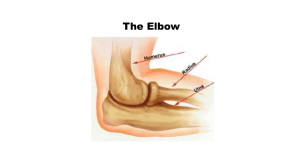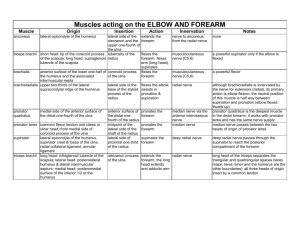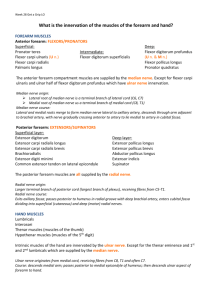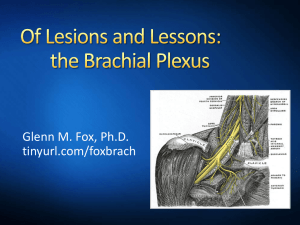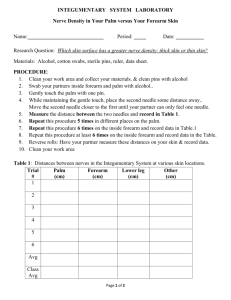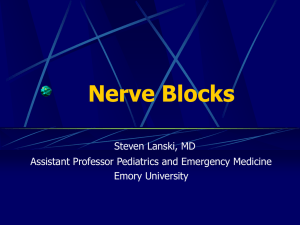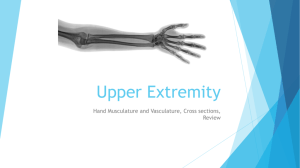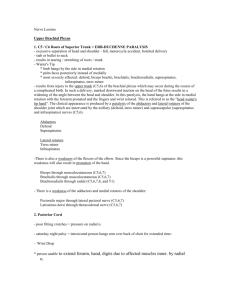OTA Elbow Student Presentation
advertisement
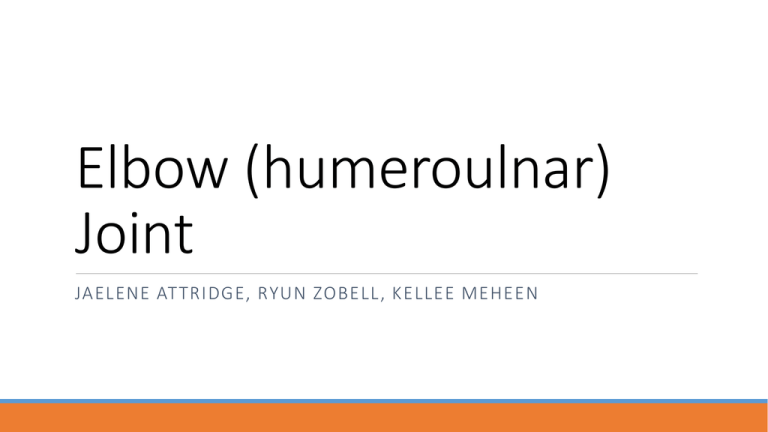
Elbow (humeroulnar) Joint JAELENE AT TRIDGE, RYUN ZOBELL, KELLEE MEHEEN Humerus Capitulum Trochlea Olecranon Fossa Medial Epicondyle Lateral Epicondyle Coronoid Fossa Ulna Olecranon Process Coronoid Process Ulnar Tuberosity Trochlear Notch Radial Notch Styloid Process Radius Head Neck Radial Tuberosity Ulnar Notch Styloid Process Ligaments Articular capsule Ulnar collateral ligament Radial anular ligament Radial collateral ligament Interosseous membrane Bursae Subcutaneous Olecranon Bursae Subtendinous Olecranon Bursae Intratendinous Olecranon Bursae Cartilage Articular Cartilage: is the smooth, white tissue that covers the ends of bones where they come together to form joints. Healthy cartilage in our joints makes it easier to move. It allows the bones to glide over each other with very little friction. Articular Capsule An articular capsule is an envelope surrounding a synovial joint. Each Joint capsule has two parts. ◦ Fibrous layer: the outer fibrous part of the capsule of a synovial joint. ◦ Synovial membrane: Is the soft tissues found between the articular capsule and the joint cavity Nerves Mickey Mouse University Musculocutaneous Nerve: arises from the lateral cord of the brachial plexus, pierces the coracobrachialis, and then continues distally between the brachialis and the biceps. Supplies muscles of the anterior upper arm. ◦ Biceps Brachii ◦ Brachialis Median Nerve: is formed in the axilla by the union of the medial and lateral roots from the medial and lateral cords of the brachial plexus. Supplies most of the muscles of the anterior forearm. ◦ Pronator teres ◦ Flexor Carpi Radialis ◦ Palmaris Longus Nerves Ulnar Nerve: arises from the medial cord of the brachial plexus. ◦ Flexor Carpi Ulnaris Radial Nerve: enters the arm posterior to the brachial artery, medial to the humerus, and anterior to the long head of the triceps. Supplies muscles in the posterior compartments of the arm. ◦ ◦ ◦ ◦ ◦ Triceps Brachii Supinator Brachioradialis Extensor Carpi Radialis Longus Extensor Carpi Radialis Brevis The medial and ulnar supply articular branches to the elbow joint. Vascular Supply : Arteries: ◦ ◦ ◦ ◦ ◦ ◦ ◦ Brachial Ulnar Radial Deep brachial Recurrent interosseous-Supinator Anterior interosseous Posterior interosseous Veins: ◦ ◦ ◦ ◦ ◦ Cephalic Basilic Median antebrachial Brachial Median cubital Arteries: Brachial ◦ Provides the main arterial supply to the arm and is the continuation of the axillary artery. It divides into the ulnar artery and the radial artery. Used for measuring BP. Deep Brachial ◦ Branch off of the brachial artery which travels along the humerus. It supplies blood to most brachial arm muscles. Arteries Ulnar ◦ Descends through the anterior compartment of the forearm, deep to the pronator teres muscles. Radial ◦ The radial artery supplies the posterior aspect of the forearm and the ulnar artery supplies the anterior aspect. Convenient for taking pulse Arteries Recurrent interosseous: ◦ supplies the deep layer of the anterior compartment of the forearm toward the pinky on the ulnar side, including the flexor digitorum profundus, flexor pollicis longus, supinator and pronator quadratus muscles. Anterior interosseous: ◦ The anterior interosseous artery supplies the deep layer of the anterior compartment of the forearm, including the flexor digitorum profundus, flexor pollicis longus, and pronator quadratus muscles. Posterior interosseous: ◦ passes backward between the oblique cord and the upper border of the interosseous membrane. It appears between the contiguous borders of the supinator and the abductor pollicis longus, and runs down the back of the forearm between the superficial and deep layers of muscles, to both of which it distributes branches. Veins: Cephalic: ◦ proceeds along the lateral border of the wrist and the anterolateral surface of the forearm and arm Basilic: ◦ Medial side of the forearm and inferior part of the arm. Median antebrachial: ◦ ascends in the middle of the anterior aspect of the forearm Veins Median cubital: ◦ passes obliquely across the anterior aspect of the elbow and joins the basilic vein. Brachial: ◦ begins at the elbow and ends by merging with the basilic vein to form the axillary vein Muscles Biceps Brachii (Musculocutaneous Nerve) O: Short head: Coracoid process Long head: Supraglenoid tubercle of scapula I: Radial Tuberosity and Bicipital Aponeurosis A: Supinates forearm, with forearm supinated flexes forearm, long head flexes arm Muscles Brachialis (Musculocutaneous Nerve) O: Distal ½ of anterior surface of humerus I: Coronoid process and ulnar tuberosity A: Flexes forearm Muscles Triceps Brachii (Radial nerve) O: Long head: Infraglenoid tubercle Lateral head: Posterior surface of humerus superior to radial groove Medial head: Posterior surface of humerus inferior to radial groove I: Proximal end of Olecranon process A: Extension of the forearm, Long head extends arm, resists dislocation Muscles Supinator (Radial nerve) O: Lateral epicondyle, radial collateral nerve and anular ligaments I: Lateral, posterior and proximal 1/3 of radius A: Supinates forearm Pronator teres (Median nerve) O: Ulnar head: Coronoid process of ulna Humeral head: Medial epicondyle of humerus I: Middle of lateral surface of radius A: Forearm pronation and flexion Pronator quadratus (Anterior interosseous nerve) O: Distal ¼ of anterior surface of ulna I: Distal ¼ of anterior surface of radius A: Pronates forearm Muscles Flexor Carpi Radialis (Median nerve) O: Medial epicondyle of the humerus I: Base of 2nd and 3rd metacarpal A: Flexes and abducts hand at wrist (radial deviation) Palmaris Longus ( Median nerve) O: Medial epicondyle of humerus I: Flexor retinaculum and palmar aponeurosis A: Flexes wrist, tenses palmar aponeurosis Flexor Carpi Ulnaris (Ulnar nerve) O: Humeral head: medial epicondyle of humerus Ulnar head: olecranon process and posterior border of ulna I: Pisiform, hamulus of hamate, base of 5th metacarpal A: Flexes and adducts hand at wrist (ulnar deviation) Muscles Brachioradialis (Radial nerve) O: Proximal 1/3 of lateral supra-epicondylar ridge of humerus I: lateral surface of distal end of radius A: Weak flexion of forearm Muscles Extensor Carpi Radialis Longus (Radial nerve) O: Lateral supra-epicondylar ridge of humerus I: Dorsal aspect of base of 2nd metacarpal A: extends and abducts wrist Extensor Carpi Radialis Brevis (Radial nerve) O: Lateral supra-epicondylar ridge of humerus I: Dorsal aspect of base of 3rd metacarpal A: Extends and abducts wrist Extensor Digitorum (Posterior Interosseous nerve) O: Lateral epicondyle I: Extensor tendons of medial 4 fingers at distal digits A: Extends fingers (digits 2-5) at MCP, PIP, DIP Surface Anatomy Lateral Epicondyle Medial Epicondyle Radial Styloid Process Ulnar Styloid Process Olecranon Cubital Fossa Carrying Angle Clinical concerns Tennis Elbow (Lateral Epicondylitis) oResults from trauma or overuse of the common extensor tendon of the posterior forearm muscles. Pain arises from lateral epicondyle of humerus. Most often results from repeated forceful contraction of forearm extensors such as a backhand shot in tennis. Treatment oRest, Ice, painkiller(ibuprofen), stopping activities, or learning new techniques, surgery is a last resort Carpal tunnel syndrome Tendons and median nerve are in the tunnel formed by the flexor retinaculum. When the tendons or the median nerve get compressed in the tunnel, it results in Carpal tunnel syndrome. Common cause is overuse, common in people that use the computer. Also common in females in the last trimester due to increased water retention resulting in compression within the carpal tunnel. Characterized by pain and sometimes sensory and motor loss of the hand. Treatment includes splinting, anti-inflammatory drugs and in severe cases, surgery in which the flexor retinaculum is incised, opening the carpal tunnel and relieving pressure. Things to remember oThe Elbow is a hinge joint, which means its movement is confined to a single axis, like the hinge on a door oThe elbow is an extremely stable joint because: o The articular capsule is very thick o The bony surfaces of the humerus and ulna interlock very well, providing a solid bony support o Multiple strong supporting ligaments help reinforce the articular capsule oBecause the elbow is extremely stable the tradeoff is that it is not as mobile as other joints, such as the glenohumeral joint oMickey Mouse University, PFPF
